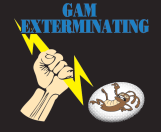Our Green Commitment

Part of GAM Exterminating’s commitment to our environmentally friendly, and green sustainability efforts is our commitment to following the methods expressed in the philosophy of Integrated Pest Management (IPM). IPM is a system designed a few basic components to control pests in the most efficient and environmentally friendly way. By following our systematic IPM approach, we are able to provide our clients the necessary effective results they need while still remaining to our green commitment. Below is the process of the IPM system we use to service our clients.
The first step to IPM is proper pest identification, this is because if you don’t know what kind of pest you’re dealing with, it’s very difficult to come up with a successful management plan. It is important to inspect the location, look for evidence of pest activity, as well as interview the client to understand what they are experiencing.
Preventive cultural practices—Selecting varieties best for local growing conditions and maintaining healthy crops is the first line of defense. Plant quarantine and ‘cultural techniques’ such as crop sanitation are next, e.g., removal of diseased plants, and cleaning pruning shears to prevent spread of infections. Beneficial fungi and bacteria are added to the potting media of horticultural crops vulnerable to root diseases, greatly reducing the need for fungicides. For interior/structural pest control. Other methods of preventive cultural practices include sanitation. Eliminating clutters, food sources, shelter, harborage areas, standing water, trash and other needs for pests to survive is an effective method in reducing the risk of a pest population.
Monitoring—Regular observation is critically important. Observation is broken into inspection and identification. Visual inspection, insect and spore traps, and other methods are used to monitor pest levels. Record-keeping is essential, as is a thorough knowledge target pest behavior and reproductive cycles. Since insects are cold-blooded, their physical development is dependent on area temperatures.
Mechanical controls— If in the event a pest reaches an unacceptable level, mechanical methods are the first options. They include simple hand-picking, barriers, traps, and vacuuming to disrupt breeding.
Biological controls—Natural biological processes and materials can provide control, with acceptable environmental impact, and often at lower cost. The main approach is to promote beneficial insects that eat or parasitize target pests. Biological insecticides, derived from naturally occurring microorganisms.
Responsible pesticide use— There are many “chemicals” that are used in pest management situations, but not all chemicals are alike from the standpoint of their range of action, toxicity, or persistence in the environment. Pesticides are used as required and often only at specific times in a pest’s life cycle. Such pesticides we use are derived from plants or naturally occurring substances (e.g.—nicotine, pyrethrum and insect juvenile hormones). Applications of pesticides must reach their intended targets. Matching the application technique to the crop, the pest, and the pesticide is critical.
Biorational chemicals are those that are less universally toxic and target a specific aspect of pest biology. An example might be diatomaceous earth used to scratch the surface of insects to dehydrate them, or microbial pesticides that affect only a specific group of insects.
There are some biorational chemical tactics that are hard to classify by toxicity or that are used together in innovative ways with other tactics. An example of this would be insect pheromones used together with sticky traps. Pheromones are the chemicals produced by insects to attract their mates, and so these substances are not toxic. But they can be used in large amounts to “confuse” the mating process or to attract insects to a trap. Other examples of such chemicals are repellants, attractants, and antifeeding agents.
More About Eco-Friendly Pest Control Services
Protecting the health and safety of our clients and the environment continues to be our first priority. Our “Green Services” use pest management practices that do not rely on chemical applications alone to control pests. If a chemical is required, organically derived materials and those exempt from EPA registration are used.
Non-chemical tactics include improved environmental sanitation efforts and structural repairs such as sealing holes to deny pests access to a structure, and eliminating pest food, water, and shelter sources. However, some pests such as bed bugs, fleas, bees and wasps are treated using materials that are designated by the EPA as “least toxic” and/or “low impact”. These alternative pest management methods are available to all our residential, commercial and industrial clients.
GAM Exterminating remains committed to providing environmentally-sensitive pest control services. As new products and methods are developed, our “Green Services” will continue to evolve in order to provide effective pest management while protecting the health and safety of our clients and the environment.

